All instruments are available for use separately or as part of a screening weekly access option. Visit our facility access page for more information on using any of the instruments below.
HTSF Instrumentation
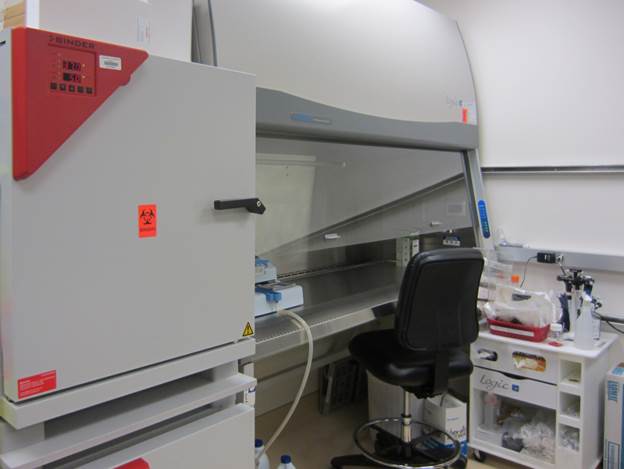 The 461 LKS HTSF Cell Culture Hood is equipped with a BL-2 laminar flow Hood, 2 CO2 incubators, centrifuges, epifluorescent/phase EVOS inverted microscope, water bath, -20C freezer, hemocytometer, Scepter cell counter, and storage space (each lab keeps their own stock of supplies).
The 461 LKS HTSF Cell Culture Hood is equipped with a BL-2 laminar flow Hood, 2 CO2 incubators, centrifuges, epifluorescent/phase EVOS inverted microscope, water bath, -20C freezer, hemocytometer, Scepter cell counter, and storage space (each lab keeps their own stock of supplies).
The HTSF has two automated cell plating Combidrop instruments for either 96- or 384-well cell seeding. Typically the hood is used for maintenance and seeding of plates of mammalian cells. Careful sanitation processes are followed to prevent cross-contamination. 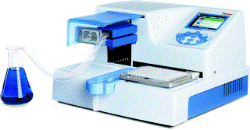 We also now have a Biotek Multiflo (see below) for cell seeding, please contact HTSF staff about using the best equipment for the task.
We also now have a Biotek Multiflo (see below) for cell seeding, please contact HTSF staff about using the best equipment for the task.
The HTSF offers the Agilent Bravo Automated Liquid Handling Platform because it is one of the most compact yet versatile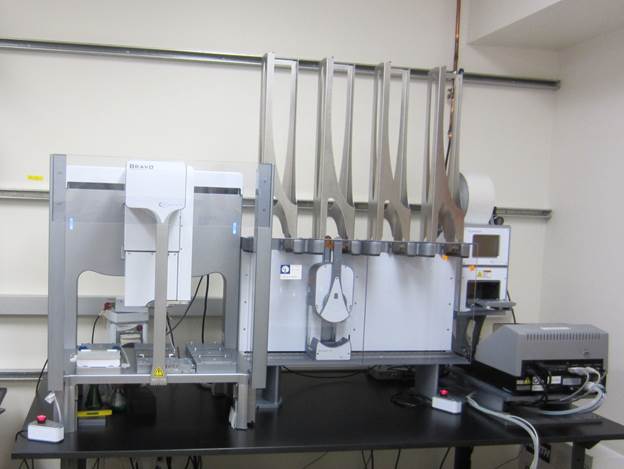 instruments available to the biotech industry. It is equipped for operations with either a 96- or 384 well head and the platform can be customized for a wide range of assays, providing locations for tips, plates, waste, reagents and wash stations on its nine pipettable deck positions. On the HTSF system, there is a separate shaker and an incubation station, as well as grippers within each head for the removal of lids or movement of plates. The 96LT head pipette tips (250ml) are accurate between 2-250 ml. The 384 head pipette tips (either 10, 30, or 70ml) give accurate pipetting from 0.3-70 ml. Common uses are spotting compound plates to numerous daughter plates, reverse transfections, media changes, drug additions, and immunofluorescence assays. The automation method writing software, Vworks, presents an easy-to-navigate interface to create methods or modify a library of methods already developed on it by previous V11 users. For those developing more sophisticated processes, the HTSF V11 is fully integrated with 4 plate stackers to assist with multiple automation steps, a plate washer that is gentle enough for attached cell-based assays, and finally a plate sealer to apply an appropriate protective film over the plate after processing.
instruments available to the biotech industry. It is equipped for operations with either a 96- or 384 well head and the platform can be customized for a wide range of assays, providing locations for tips, plates, waste, reagents and wash stations on its nine pipettable deck positions. On the HTSF system, there is a separate shaker and an incubation station, as well as grippers within each head for the removal of lids or movement of plates. The 96LT head pipette tips (250ml) are accurate between 2-250 ml. The 384 head pipette tips (either 10, 30, or 70ml) give accurate pipetting from 0.3-70 ml. Common uses are spotting compound plates to numerous daughter plates, reverse transfections, media changes, drug additions, and immunofluorescence assays. The automation method writing software, Vworks, presents an easy-to-navigate interface to create methods or modify a library of methods already developed on it by previous V11 users. For those developing more sophisticated processes, the HTSF V11 is fully integrated with 4 plate stackers to assist with multiple automation steps, a plate washer that is gentle enough for attached cell-based assays, and finally a plate sealer to apply an appropriate protective film over the plate after processing.
The HTSF also has a Beckman-Coulter Biomek NX with a Span-8 attachment, which means 8 independently functioning tip positions. This instrument can be used for methods like creating dilution series, plate re-arrays, hit picking, and other uses where not all wells are treated the same. The tips that you order for the Span-8 allow for high precision pipetting of a wide range of volumes. The instrument is enclosed in a HEPA filtered enclosure to provide a clean environment for processes, whether cellular or compound manipulations.
The software driving the method writing uses Beckman-Coulter’s unique point-and-click programming to create protocols easily understandable to researchers who don’t have an automation programming background. Alternatives such as pipetting techniques, liquid types and deck layouts can be chosen from drop-down lists. Method validation features will check your method and find any logical errors. The Estimated Time to Completion (ETC) feature will provide you with an accurate runtime, enabling you to speed up methods development and efficiently plan your instrument use. Variables, worklists and logicals can be used to vary runs without reprogramming.
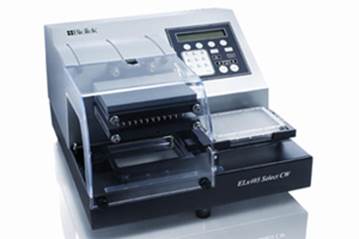 The ELx405 family of washers has been designed to meet the challenges of various applications, reliability, easy maintenance, yet cost-effectiveness. The ELx405 series of washers use BioTek Instruments’ patented manifold design to overcome the difficulties presented by high-density microplates and allows virtually the same functionality to be applied to 384-well plates as that is expected with 96-well microplate. The dispense and aspiration manifolds are placed into two physically different parts that are arranged on top of each other. The HTSF has the model (ELx405UCWVS (ELx405 Select CW) that is optimized for loosely adherent cells to allow for washing of HTS plates with minimal disruption to cell attachment. Multiple containers are available to create different buffers for washing or fixation steps.
The ELx405 family of washers has been designed to meet the challenges of various applications, reliability, easy maintenance, yet cost-effectiveness. The ELx405 series of washers use BioTek Instruments’ patented manifold design to overcome the difficulties presented by high-density microplates and allows virtually the same functionality to be applied to 384-well plates as that is expected with 96-well microplate. The dispense and aspiration manifolds are placed into two physically different parts that are arranged on top of each other. The HTSF has the model (ELx405UCWVS (ELx405 Select CW) that is optimized for loosely adherent cells to allow for washing of HTS plates with minimal disruption to cell attachment. Multiple containers are available to create different buffers for washing or fixation steps.
 The EVOS M5000 Imaging System is a fully digital inverted microscope for four-color fluorescence, transmitted light, and color applications, making it an exceptionally versatile microscope, ideal for a broad range of imaging applications. The HTSF microscope has 4x, 10x, 20x, and 40x objectives and DAPI, GFP, RFP, and Cy5 excitation/emission filter cubes.
The EVOS M5000 Imaging System is a fully digital inverted microscope for four-color fluorescence, transmitted light, and color applications, making it an exceptionally versatile microscope, ideal for a broad range of imaging applications. The HTSF microscope has 4x, 10x, 20x, and 40x objectives and DAPI, GFP, RFP, and Cy5 excitation/emission filter cubes.
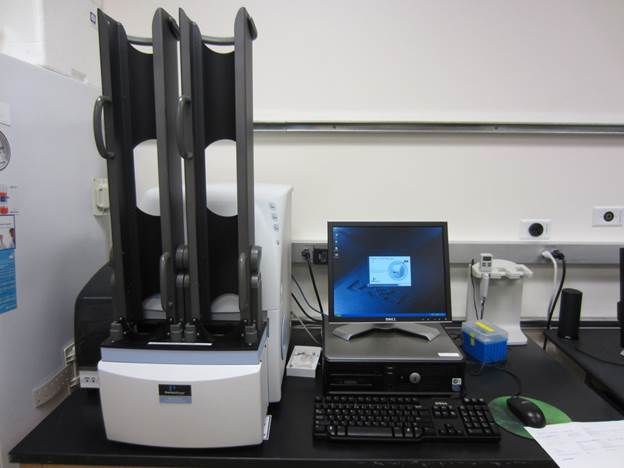 The EnVision Plate reader 2104 is a rapid, sensitive, and versatile multi-use plate reader that acquires luminescence, and absorbance and bottom or top read of fluorescence. Most common fluorescence excitation and emission filters are available as well as a couple of FRET, and fluorescence polarization combinations. The HTSF unit is also capable of doing kinetic experiments including glow, flash and dual luminescence. It also comes with a plate stacker for “walk-away” acquisition of multiple plates.
The EnVision Plate reader 2104 is a rapid, sensitive, and versatile multi-use plate reader that acquires luminescence, and absorbance and bottom or top read of fluorescence. Most common fluorescence excitation and emission filters are available as well as a couple of FRET, and fluorescence polarization combinations. The HTSF unit is also capable of doing kinetic experiments including glow, flash and dual luminescence. It also comes with a plate stacker for “walk-away” acquisition of multiple plates.
The flexible EnVision can perform fast kinetic measurements, enzyme assays and numerous other cell-based drug discovery assays. The easy-to-use software aids with acquisition setup and analysis.
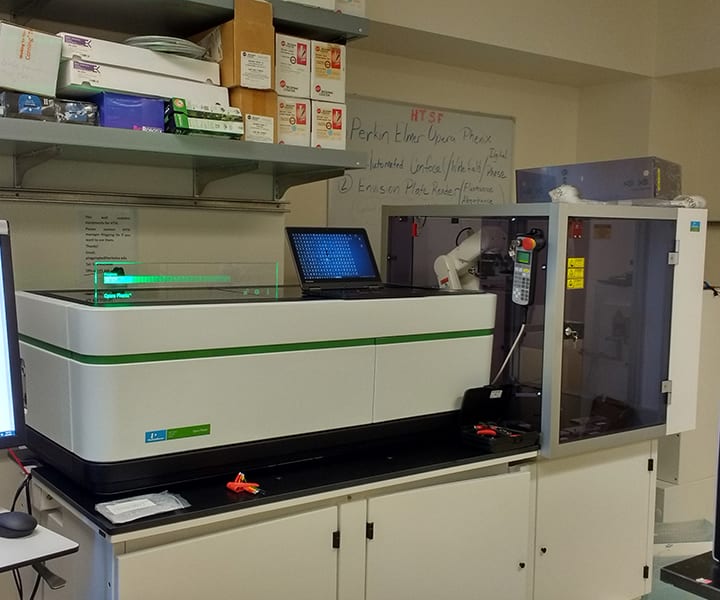 The Opera Phenix by Revvity (formerly Perkin Elmer) is a fully-integrated hardware and software system for high throughput automated confocal/epifluorescent/digital phase cell-based or tissue or organism multiwell imaging. The HTSF’s system can be environmentally controlled by temperature and 5% CO2 within the microscope. Delivery of plates from either a Liconic incubator or “hotel” stacks by a robotic plate handler can be set up for day or overnight imaging. The Screening Facility staff trains researchers on the Harmony cellular image analysis software and Columbus for high content analysis, although researchers are free to use whatever analysis pipeline that they prefer using the .tif images. Objective selections include 2x, 4x, 10x, 20x Air, 20xWater, 40x Air, high NA 40x Water, and 60x Water, and an array of emission filter capabilities including DAPI, CFP, GFP, FITC, YFP, TRITC, Cy3, TxRed, and Cy5. This microscopy system is also set up for FRET in any number of combinations. Imaging immunofluorescence slides or plate wells with randomly positioned areas to image is made easy by the use of the Opera Phenix Preciscan routine that quickly images at low magnification, automatically recognized features of interest, and then re-images only those areas of interest at higher magnification and resolution.
The Opera Phenix by Revvity (formerly Perkin Elmer) is a fully-integrated hardware and software system for high throughput automated confocal/epifluorescent/digital phase cell-based or tissue or organism multiwell imaging. The HTSF’s system can be environmentally controlled by temperature and 5% CO2 within the microscope. Delivery of plates from either a Liconic incubator or “hotel” stacks by a robotic plate handler can be set up for day or overnight imaging. The Screening Facility staff trains researchers on the Harmony cellular image analysis software and Columbus for high content analysis, although researchers are free to use whatever analysis pipeline that they prefer using the .tif images. Objective selections include 2x, 4x, 10x, 20x Air, 20xWater, 40x Air, high NA 40x Water, and 60x Water, and an array of emission filter capabilities including DAPI, CFP, GFP, FITC, YFP, TRITC, Cy3, TxRed, and Cy5. This microscopy system is also set up for FRET in any number of combinations. Imaging immunofluorescence slides or plate wells with randomly positioned areas to image is made easy by the use of the Opera Phenix Preciscan routine that quickly images at low magnification, automatically recognized features of interest, and then re-images only those areas of interest at higher magnification and resolution.
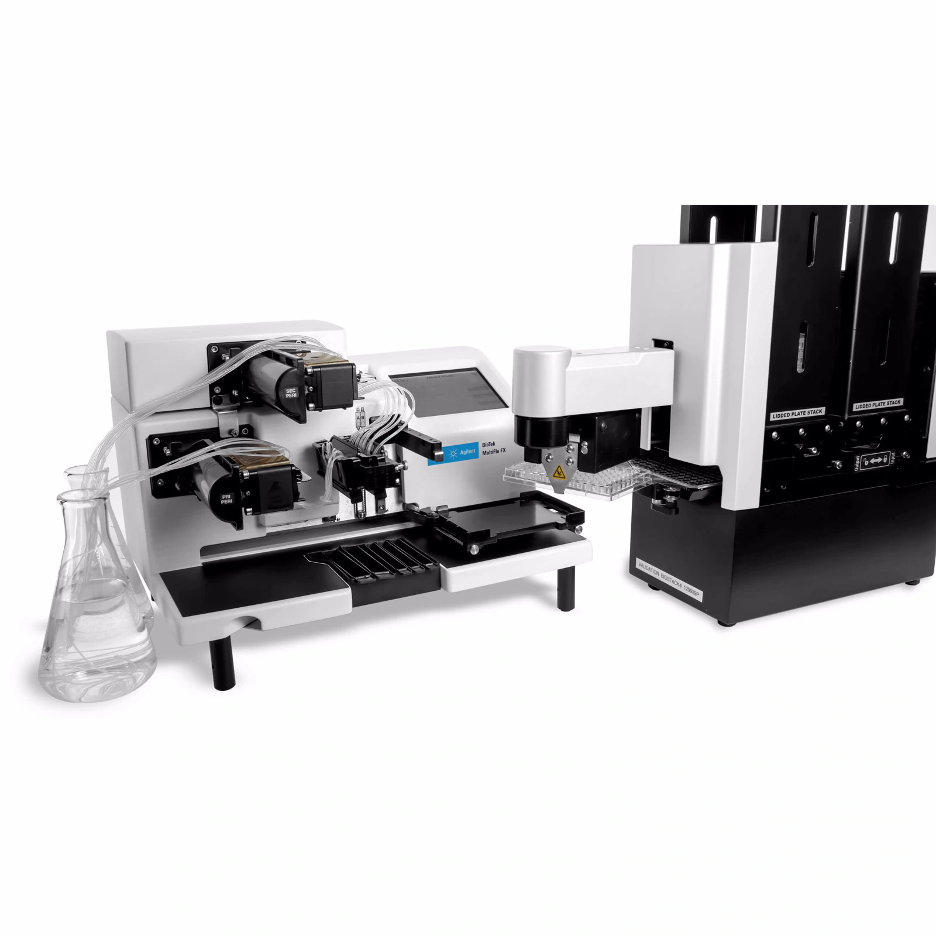 MultiFlo FX is an automated multi-mode reagent dispenser for 6- to 1536-well microplates. MultiFlo FX incorporates several unique technologies in its modular design, such as Parallel Dispense, Random Access Dispense and Automated Gentle Media Exchange modules to facilitate a variety of liquid handling applications from 2D and 3D cell culture to concentration normalization assays, IC50, ELISA, bead-based assays and more. An important feature is that it can retrieve precious samples/antibodies rather than have them go out to waste. Cassettes are purchased that match use depending on the volume and whether peristaltic or syringe pumps are needed. A computer with Liquid Handling Control software helps with process development and the Biostack4 hotel holds 10 plates with de-lidding/lidding for walk-away automated work after optimization and testing have been completed. The HTSF Multiflo and Biostack4 System are in the 461 BSL2 Biosafety cabinet.
MultiFlo FX is an automated multi-mode reagent dispenser for 6- to 1536-well microplates. MultiFlo FX incorporates several unique technologies in its modular design, such as Parallel Dispense, Random Access Dispense and Automated Gentle Media Exchange modules to facilitate a variety of liquid handling applications from 2D and 3D cell culture to concentration normalization assays, IC50, ELISA, bead-based assays and more. An important feature is that it can retrieve precious samples/antibodies rather than have them go out to waste. Cassettes are purchased that match use depending on the volume and whether peristaltic or syringe pumps are needed. A computer with Liquid Handling Control software helps with process development and the Biostack4 hotel holds 10 plates with de-lidding/lidding for walk-away automated work after optimization and testing have been completed. The HTSF Multiflo and Biostack4 System are in the 461 BSL2 Biosafety cabinet.
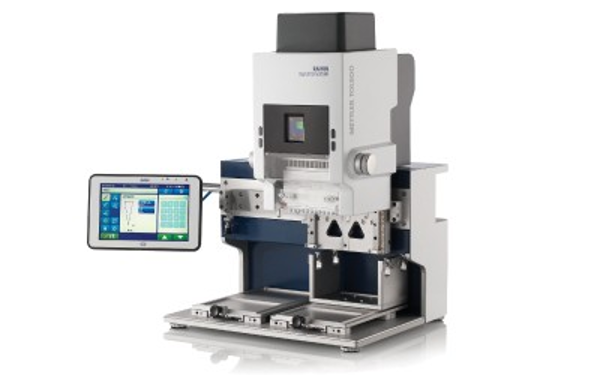 The BenchSmart™ 96 offers the precision of automation paired with the speed and flexibility of manual positioning. The BenchSmart 96’s three quick-change pipetting heads enable 96- and 384-well pipetting from 0.5 μL to 1 mL. The touchscreen display offers precision control over aspiration, dispensing, tip loading and ejection. This instrument can fit on a researcher’s lab bench.
The BenchSmart™ 96 offers the precision of automation paired with the speed and flexibility of manual positioning. The BenchSmart 96’s three quick-change pipetting heads enable 96- and 384-well pipetting from 0.5 μL to 1 mL. The touchscreen display offers precision control over aspiration, dispensing, tip loading and ejection. This instrument can fit on a researcher’s lab bench.
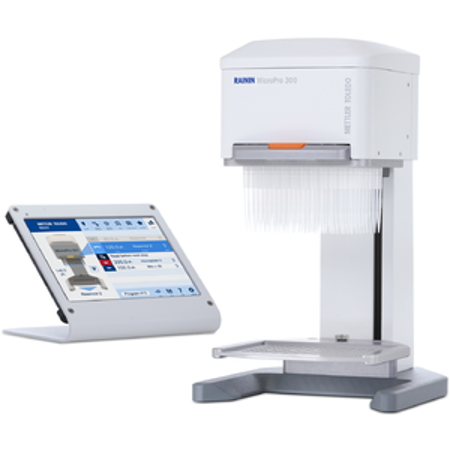 The Rainin MicroPro 300 96-channel semi-automated pipettor has a volume range of 5-300 µL and precision of 15-30 µL < 2% C.V. and 30-300 µL < 1% C.V. Features touchless tip ejection, precise speed control and the ability to save protocol. The MicroPro reduces operator error and improves reproducibility. Pre-programmed pipetting modes including multi-dispense, and multi-aspirate. Custom protocols that include your tailored instructions and liquid-handing steps are easy to create, save, edit and recall. This instrument is small enough to fit in a Biosafety cabinet with ease.
The Rainin MicroPro 300 96-channel semi-automated pipettor has a volume range of 5-300 µL and precision of 15-30 µL < 2% C.V. and 30-300 µL < 1% C.V. Features touchless tip ejection, precise speed control and the ability to save protocol. The MicroPro reduces operator error and improves reproducibility. Pre-programmed pipetting modes including multi-dispense, and multi-aspirate. Custom protocols that include your tailored instructions and liquid-handing steps are easy to create, save, edit and recall. This instrument is small enough to fit in a Biosafety cabinet with ease.
